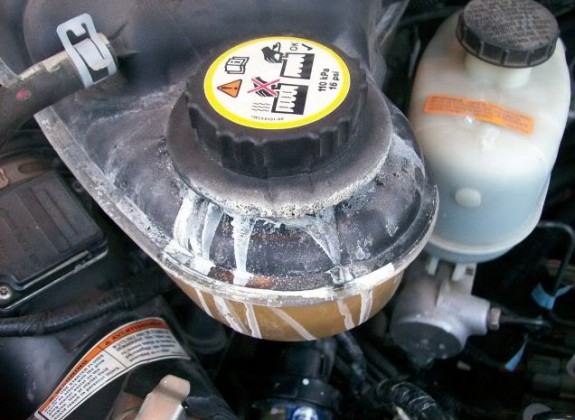Obscure Maintenance: Cooling System

The white residue indicates that the coolant has boiled over - this can be caused by a faulty $5 radiator cap or bad coolant overflow tank.
With a hot summer rapidly approaching, you might start to see ads about preparing your car’s cooling system. I used to think these ads were totally bunk. I mean, the cooling system is so simple, just add air and it should work just fine! However, after I got my diesel pickup, I started to realize that there is much more to it. Luckily, maintaining the cooling system on your vehicle is not only easy, but also the best investment you will ever make. After all, it is most likely to fail under very inhospitable conditions – why would you risk it?
The cooling system is very simple, there are only a few components to it. A few hoses, a couple fans, a pump, a thermostat, a radiator, an overflow tank, a pressure rated cap, and the coolant – that’s about it in most vehicles today. The bad news is that when any of these components fail, they can render your vehicle inoperable within a few miles. They often go bad without much advanced warning, which is irrelevant since most people don’t pay attention to the warning signs anyway. So what do you do to keep from being stranded?
First, check whether your vehicle is notorious for any cooling system problems. BMW’s in the 1990′s heading into the mid 2000′s had pretty bad cooling systems. Some of them had radiators crack, others had disintegrating water pumps, some had cooling fans that would blow apart violently enough to put a large dent in the hood. You can bet that all of these issues reared their heads before any maintenance interval recommended by BMW, so the owners manual would have been no help here. If you find that your vehicle is notorious for any of these issues, it is best to replace components before they come out to bite you.

This BMW's hood was damaged by an exploding cooling fan. Photo from racerx8413 at bimmerfest forums.
If there aren’t any known issues that you can find, then follow any recommended cooling system maintenance listed in the owners manual. Many manufacturers recommend doing a simple coolant change around 100,000 miles, which will keep enough additives in the coolant to prevent internal wear. If you drive a diesel, it is probably even more complex than that. Due to many changes in the past 10 years regarding coolant additives, you should check diesel truck forums for the latest news on coolant maintenance. This is crucial, because depleted additives in a diesel or gas engine can cause cavitation or corrosion. This can lead to many other pricey repairs. As an example, poor coolant additive maintenance on a 7.3L Powerstroke diesel can wear through the front cover of the HPOP. Sounds simple, but requires 14 hours in labor to fix – at $100/hr, you are looking at a huge bill.

The pockmarks are the result of inappropriate coolant additives. The coolant bubbled (cavitation), causing the metal housing to be eaten away. Photo courtesy of Izzy351 at Ford-Trucks.com.
However, most owners manuals won’t list anything about replacing a water pump or a thermostat since these are not considered wear items. But, you can find out whether your vehicle requires a timing belt change. Most mechanics would change the water pump while swapping out the timing belt. This was done since the two jobs involved removing the same parts, and while the water pump might still be good at the 105K timing belt change, it is not likely to make it to the next belt replacement at 210K. Thus, to save money by not having to do the same labor twice within a short period of time, it is advisable to change the timing belt and the water pump at the same time (among other parts). However, what if your vehicle, like most Honda/Toyota 4 cylinder engines built in the 2000′s, uses a timing chain that doesn’t have to be changed? The water pump will still fail at some point. If you’re taking your family out to the desert in summer with a water pump that has 150,000-200,000 miles on it, especially if the coolant had been neglected the whole time, you might want to change it out just for peace of mind. And, lest you believe that imports are bulletproof, I will introduce you to my coworkers 2005 Toyota Camry, which has had 3 different water pumps installed in the first 100,000 miles of operation. There is just no telling when these things will fail.

The part on the right is a thermostat housing from a 7.3L Powerstroke diesel. It often can rust completely through and cause leaks if not monitored. Photo from -Nathan- at Powerstroke.org.
Finally, replace the coolant hoses and overflow tank when they get old. While these are not wear items, they are made of rubber and plastic – they will become brittle as the decade mark approaches, and will drain all your coolant if they crack. While you’re at that, replacing the thermostat and radiator cap is always a good idea. These two items won’t cost more than $50 between the two of them, and will prevent you from taking a long walk. Take note of the radiator cap in particular if you drive a Ford product – they are known to fail and let the coolant boil at a much lower temperature.

